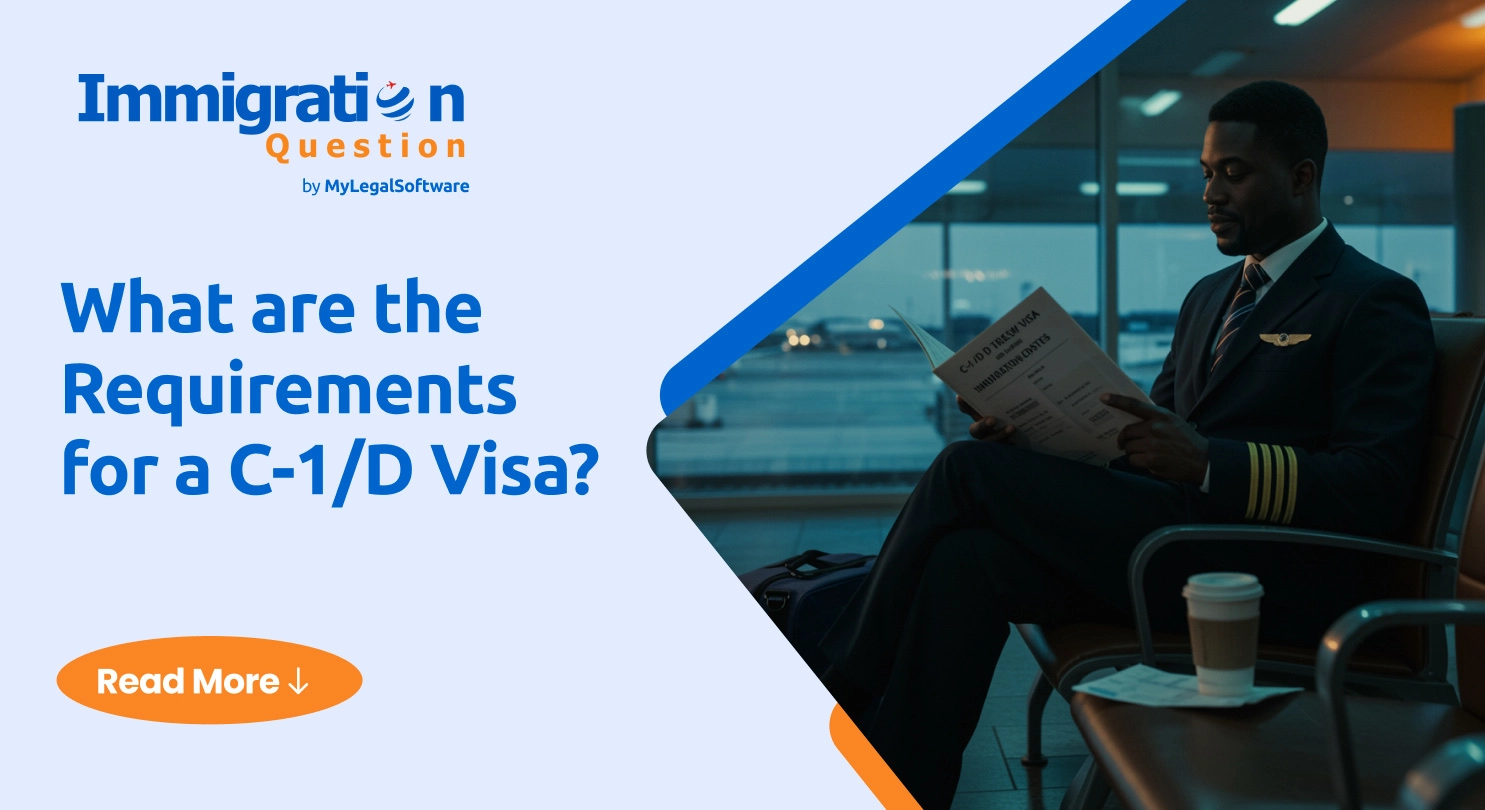Cruise ship, cargo vessel, or international airline workers whose duties require them to travel to the United States may need a nonimmigrant visa designed for crew members, known as a C-1/D visa. This visa classification covers both transit (C-1) and crewmember (D) visa purposes.
This blog covers the C-1/D visa requirements, the application process, required documents, and details you should know before applying.
What Is a C-1/D Visa?
The C-1/D visa is a combination of two visa types:
- The C-1 visa allows foreign nationals to transit through the U.S. and
- The D visa permits foreign crew members to enter the United States to perform duties essential to the operation of a sea vessel or aircraft.
If you are applying for both and your country is eligible under the U.S. visa reciprocity schedule, you may be issued a combined C-1/D visa.
Who Needs a C-1/D Visa?
You may need a C-1/D visa if:
- You are working aboard a commercial sea vessel or international airline;
- You plan to enter and depart the U.S. on the same vessel or another within 29 days;
- You are not seeking to stay in the U.S. for long-term work or permanent residence.
Crewmember Roles include:
- Pilots and flight attendants
- Ship engineers
- Deckhands
- Stewards
- Cooks and other service staff on board
C-1/D Visa Requirements
To qualify for a C-1/D visa, you must meet the following criteria:
Employment
- Be employed in a role essential to the functioning of the vessel or aircraft.
- Provide evidence of employment (e.g., a letter from the employer, crew manifest).
According to the U.S. Department of State, you can apply even if you are not employed at the time of application, but you must be employed on the vessel or aircraft when entering the U.S.
Travel Intent
You must intend to leave the U.S. once your duties are completed.
You must enter and depart the U.S. as part of your job assignment.
How to Apply for a C-1/D Visa?
The application process involves multiple steps. It includes:
1. Complete Form DS-160
Submit the Online Nonimmigrant Visa Application (Form DS-160) at the Consular Electronic Application Center. Print the confirmation page.
2. Upload Your Photo
Upload a recent passport-style photo that meets the U.S. State Department’s photo requirements. If the upload fails, bring a printed photo to the interview.
3. Pay the Application Fee
The non-refundable visa fee for the C-1/D visa, as of May 2025, is $185.
4. Schedule a Visa Interview
Book your interview at the U.S. Embassy or Consulate in your home country.
Documents Required for a C-1/D Visa
Here is a checklist of documents you will need to apply:
- Passport valid for at least six months beyond your intended stay)
- DS-160 confirmation page
- Visa fee payment receipt
- Passport-style photograph
- Employment verification or letter from the employer
- Crew manifest or employment contract
- Proof of intent to depart the U.S., such as return tickets or ship schedules
- Proof of ability to cover trip expenses
These are the essential C-1/D requirements, but you may be asked to submit additional documents based on your case.
What to Expect at the Visa Interview?
A consular officer will review your application and documents and interview you to verify that you meet the requirements for a C-1/D visa. Be prepared to answer questions about:
- Your job role and employer
- Your travel plans
- Your previous travel history
- Your intent to return to your home country
Period of Stay for C-1/D Visa Holders
Non-lightering D visa holders must depart the U.S. within 29 days. D-3 visa holders (lightering crewmembers) may stay up to 180 days. You cannot extend or change your status from a C-1/D visa while in the U.S.
Family Members of C-1/D Visa Holders
Spouses and unmarried children under 21 cannot accompany you on a C-1/D visa. If they wish to join you temporarily, they must apply for a B-2 visitor visa or any other visa category that suits their travel purpose.
This visa enables you to do your job while ensuring compliance with U.S. immigration law. It is advisable to hire an immigration lawyer to assist with the process. Visit Immigration Question to hire an experienced attorney today.
Frequently Asked Questions (FAQs)
1. What is the difference between a C-1 visa and a D visa?
The C-1 visa is for foreigners transiting through the United States, while the D visa is specifically for crew members working on sea vessels or international airlines. Most applicants apply for a combination C-1/D visa if they meet the eligibility criteria for both.
2. Can I extend my stay on a C-1/D visa?
The C-1/D visa does not permit an extension or change of status while in the United States. It is strictly a nonimmigrant visa intended for short-term stays related to your duties.
3. Can my family come with me on a C-1/D visa?
Family members of C-1/D visa holders are not eligible for a dependent visa under this category. However, your spouse and unmarried children under 21 may apply for a B-2 visitor visa if they wish to accompany you to the U.S. temporarily.
4. What can I do if my C-1/D visa is denied?
If your C-1/D visa is denied, you may reapply if:
- You have additional evidence of your qualifications or intent to return home or
- Your circumstances have changed since your last application.
5. Can I work other jobs on a C-1/D visa?
The C-1/D visa only permits you to perform duties directly related to your role as a crew member. You may not take up any other form of employment while in the U.S. on this visa.
6. Do I need employment to apply for a C-1/D visa?
You can apply without current employment, but you must show proof of employment on a sea vessel or aircraft at the time of your entry into the U.S. Your visa may not be used unless you are joining a ship or aircraft as a crewmember.





![Top 5 Immigration Questions People Asked Online This Week [May 30, 2025]](https://blog.immigrationquestion.com/wp-content/uploads/2025/05/top-5-immigration-questions-people-asked-online-this-week-may-30-2025-768x419.webp)



